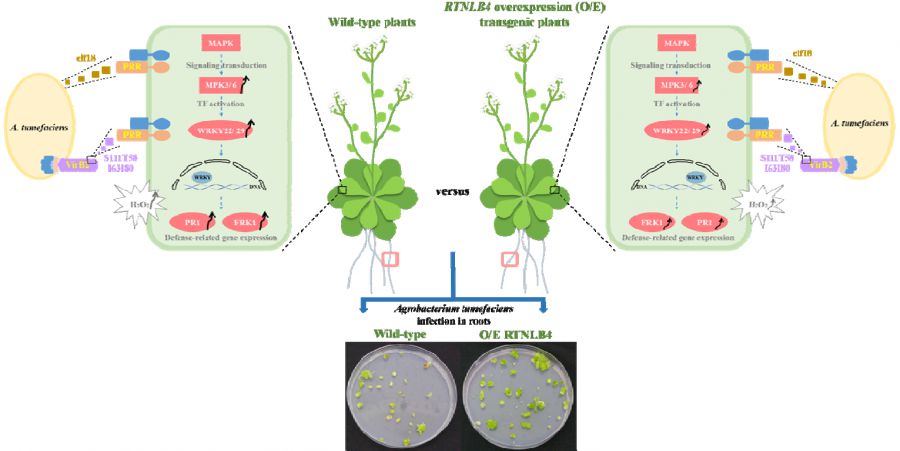循環農業:農業廢棄物再資源化【生命科學系/黃皓瑄副教授/優聘教師】
| 論文篇名 | 英文:The Arabidopsis RETICULON-LIKE4 (RTNLB4) protein participates in Agrobacterium infection and VirB2 peptide-induced plant defense response 中文:阿拉伯芥RTNLB4 蛋白質參與農桿菌感染過程和由VirB2 胜肽所誘發植物防禦反應 |
| 期刊名稱 | INTERNATIONAL JOURNAL OF MOLECULAR SCIENCES |
| 發表年份,卷數,起迄頁數 | 2020, 21 (5), 1722 |
| 作者 | Huang, Fan-Chen; Hwang, Hau-Hsuan(黃皓瑄)* |
| DOI | 10.3390/ijms21051722 |
| 中文摘要 | 農桿菌是利用由VirB1 到VirB11 和VirD4 所組成含有T 線毛(T-pilus)的第四型分泌系統,將T-DNA 和致病蛋白質傳遞至植物細胞中。致病蛋白質進入植物細胞後可藉由T-DNA 在植物細胞內的轉移、嵌入植物染色體和表現T-DNA 上的基因進而造成植物的腫瘤病。T 線毛是由許多的輪狀VirB2 蛋白質組成。目前已知阿拉伯芥的AtRTNLB4 蛋白質可與農桿菌VirB2 結合。阿拉伯芥的AtRTNLB4 蛋白質位於內質網上,且參與植物細胞內膜運輸之過程。本研究結果顯示rtnlb4 突變株較不易被農桿菌感染及AtRTNLB4 大量表現轉植株則較易被農桿菌感染之效率,顯示AtRTNLB4 極有可能參與農桿菌感染過程。為了近一步了解AtRTNLB4 在細菌感染過程中的角色,我們以農桿菌的分子治病圖譜elf18 胜肽處理植株小苗後,可觀察到AtRTNLB4 基因被誘導表現。且經elf18胜肽處理後,在rtnlb4 突變株,或是大量表現AtRTNLB4 轉殖株中,防禦相關基因(包含PR1、FKR1、WRKY22 及WRKY29)的表現量都低於野生株。若以農桿菌感染預先處理elf18 胜肽之小苗,可能因植物防禦相關基因被誘導表現,使得農桿菌的感染此類小苗效率降低,而在rtnlb4 突變株或是大量表現AtRTNLB4 轉殖株中,感染率降低的幅度皆小於野生株,推測可能是因AtRTNLB4 基因表現量異常進而影響了elf18 胜肽所誘導的植物防禦反應。另分析經農桿菌VirB2 胜肽預先處理小苗之感染率,得知大量表現AtRTNLB4 轉殖株或是rtnlb4 突變株,兩者感染率降低的幅度同樣小於野生株,與elf18 胜肽預處理後的結果相似。此外若以VirB2 胜肽處理野生株,可誘導FKR1、WRKY22 及WRKY29 等防禦相關基因的表現,但在大量表現AtRTNLB4 轉殖株或是rtnlb4 突變株中,防禦相關基因被誘導表現的程度小於野生株。且以農桿菌VirB2 胜肽處理野生株小苗可抑制幼苗生長和促使過氧化物(reactive oxygen species、ROS)產生。因此,AtRTNLB4 極可能參與了elf18 和VirB2 胜肽所誘導的植物防禦反應,並因而影響農桿菌的感染過程。 |
| 英文摘要 | Agrobacterium tumefaciens uses the type IV secretion system, which consists of VirB1-B11 and VirD4 proteins, to deliver effectors into plant cells. The effectors manipulate plant proteins to assist in T-DNA transfer, integration, and expression in plant cells. The Arabidopsis reticulon-like (RTNLB) proteins are located in the endoplasmic reticulum and are involved in endomembrane trafficking in plant cells. The rtnlb4 mutants were resistant to A. tumefaciens infection, but overexpression of RTNLB4 in transgenic plants was hyper-susceptible to A. tumefaciens transformation, which suggests the involvement of RTNLB4 in A. tumefaciens infection. The expression of defense-related genes, including FRK1, PR1, WRKY22, and WRKY29, were less induced in RTNLB4 overexpression (O/E) transgenic plants after A. tumefaciens elf18 peptide treatment. Pre-treatment with elf18 peptide decreased Agrobacterium-mediated transient expression efficiency more in wild-type seedlings than RTNLB4 O/E transgenic plants, which suggests that the induced defense responses in RTNLB4 O/E transgenic plants might be affected after bacterial elicitor treatments. Similarly, A. tumefaciens VirB2 peptide pretreatment reduced transient T-DNA expression in wild-type seedlings to a greater extent than in RTNLB4 O/E transgenic seedlings. Furthermore, the VirB2 peptides induced FRK1, WRKY22, and WRKY29 gene expression in wild-type seedlings but not efr-1 and bak1 mutants. The induced defense-related gene expression was lower in RTNLB4 O/E transgenic plants than wild-type seedlings after VirB2 peptide treatment. These data suggest that RTNLB4 may participate in elf18 and VirB2 peptide-induced defense responses and may therefore affect the A. tumefaciens infection process. |







